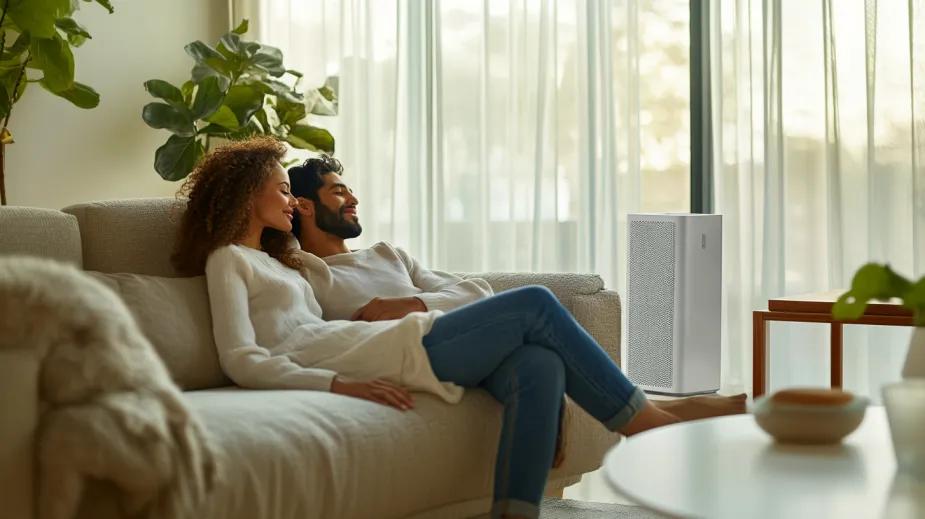Breathe New Life Into Your Home: Understanding and Fixing Stale Air

Have you ever walked into a room and noticed the air felt stale or stuffy? Stale air can make a space feel heavy and musty, leaving your home uncomfortable, unhealthy, and uninviting. Stale air is commonly found in homes with poor ventilation, high humidity, or low indoor air quality.
Fortunately, you can address stale air with a few simple DIY steps or by installing air purification systems and dehumidifiers. HVAC.com explores what causes stale air and how you can refresh your space.
What Is Stale Air?
Stale air is simply air that’s lost its freshness because of trapped carbon dioxide, excess moisture, and various contaminants. It usually feels stuffy and can carry unpleasant odors, which makes the air feel less clean and comfortable.
Common Causes of Stale Air
- Poor Ventilation: Poor ventilation is a problem in many American homes. When there’s not enough airflow, fresh air can’t circulate properly, causing indoor pollutants and moisture to build up. This stagnant air can make the space feel heavy and unpleasant.
- High Humidity: Excess moisture from activities like cooking, showering, or drying clothes indoors can lead to mold growth and musty smells. Without proper airflow, this increased humidity makes the air feel stale.
- Indoor Pollutants: Dust, smoke, and chemicals in the air can also make it feel heavy and can trigger respiratory issues and allergies.
- Occupancy: When several people are in a home, carbon dioxide levels rise. This, combined with poor ventilation and other factors, can make the air feel stale and reduce the air quality and overall comfort.
Health Issues Associated with Stale Air
Aside from decreasing comfort levels, stale air can cause health issues including:
- Respiratory Problems: Stale air often contains high levels of dust, mold spores, allergens, and other contaminants, which can irritate your lungs and make conditions like asthma worse.
- Allergies: Poor air quality can make allergy symptoms worse, causing issues like sneezing, a runny nose, itchy eyes, and congestion. This can happen because allergens like pollen, dust mites, and pet dander build up in the air.
- Headaches and Dizziness: Poor ventilation and high carbon dioxide levels can lead to headaches, dizziness, and fatigue because of a lack of fresh, oxygen-rich air.
- Fatigue: Poor indoor air quality can cause you to feel more tired and sluggish, making it harder to stay alert and focused.
- Skin Irritation: Dry, stale air can dry out your skin and make conditions like eczema and dermatitis worse.
- Mold-Related Issues: High humidity and poor airflow encourage mold growth, which can worsen respiratory issues and allergies.
- Unpleasant Odors: Stale air can smell musty and unpleasant, leading to discomfort and affecting your overall well-being.
How to Refresh Your Home’s Air Supply
Refreshing your space is the key to a healthier and more pleasant living environment. Simple steps like opening windows, using air purifiers, and keeping up with regular cleaning can significantly improve your indoor air quality and make your home more comfortable.
Open Windows
Letting in fresh outdoor air boosts circulation. Even a few minutes a day can significantly reduce stale air and improve indoor air quality. If outdoor temperatures are a concern, open windows during milder parts of the day.
Use Air Purifiers
Air purifiers remove dust, pollen, and other particles from the air, helping to keep it fresher. Portable air purifiers are commonly used to treat rooms in your home with bad indoor air quality, while whole-house air purifiers can provide coverage for an entire home.
Ventilate
Use exhaust fans in kitchens and bathrooms to expel humid and polluted air. Proper ventilation prevents moisture and contaminant buildup, keeping the air cleaner. Use fans during activities like cooking and showering.
Buy House Plants
Certain plants – like the Snake Plant, Spider Plant, and Peace Lily – improve air quality by absorbing pollutants and releasing oxygen. Place these plants in key areas to refresh the air and add greenery.
Use Dehumidifiers
Dehumidifiers reduce moisture to prevent mold and mustiness. Dehumidifiers help maintain a healthier environment by controlling indoor humidity levels, especially in areas prone to high humidity like basements and bathrooms.
Clean Regularly
Dusting and vacuuming minimize pollutants and maintain a healthier indoor environment. Regular cleaning helps remove dust, pet dander, and other debris that contribute to stale air and respiratory issues. Maintain a consistent cleaning schedule.
Install Air Circulators
Fans distribute air more evenly throughout a room, preventing stagnation and improving comfort. Use them strategically to enhance ventilation and reduce stuffiness.
Check for Leaks
Seal gaps around windows and doors to prevent drafts and improve energy efficiency. Addressing leaks helps maintain a consistent temperature and prevents outdoor pollutants from contributing to stale air. Regularly inspect and repair any gaps.
Avoid Indoor Smoking
Smoking indoors significantly deteriorates air quality by introducing harmful chemicals and toxins. These pollutants contribute to stale air and can negatively affect respiratory health. Avoid smoking inside to maintain a healthier indoor atmosphere.